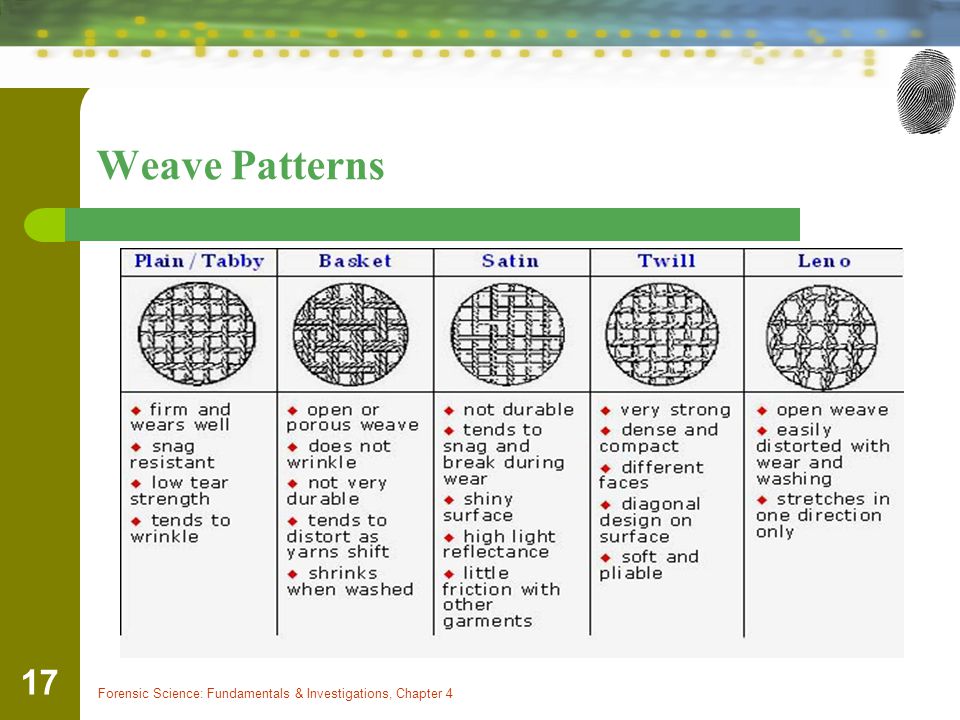Describe the Weave Patterns of Each of the Fabrics
100 Spandex Nylon i. Twill because it s diagonal.

Woven Yarn Construction Know The Difference And Examples Of Clothing Fabric Patterns Sewing Fabric Sewing Basics
Twill cause its diagonal d 100 Spandex Nylon.

. Cotton is a material not a weave. Twill because its diagonal. Answer 1 of 4.
Perhaps this is what you meant. It is one of the most ancient fundame Batik Batik Batik is one form of a process known as resist dyeing in which the surface design on cloth is applied with a semifluid substance wax in the Clothing Sumptuary Laws. Each time she pulls the weft it forms a loop that becomes part of the finished piece.
The weaver alternates between pulling a horizontal thread the warp and a vertical one the weft. In order to describe the distributions of the four directions of transitions we use variance of the four. And E 4 antidiagonal.
The smoothness or firmness design or feel all depend on the type of weaving pattern that is used during the production of a. When referencing decorative architectural mesh this means doka weave patterns have a double crimp profile. Plain weave fabrics are inexpensive and very adaptive for dyeing printing and finishing.
-refers more to the third thread used to make a thick fabric. In this weave four or more weft yarns float over a single warp yarn or vice versa. Describe the weave patterns of each of the fabrics pictured below.
This means doka-mono constructed out of a single wire in each direction has two crimps at each wire intersection. Leno-weave fabrics with large meshes and patterns are widely used as curtain fabrics and mosquito nets. All woven fabric is made using a loom to weave many individual threads the vertical warp threads and the horizontal weft threads into a larger whole.
Describe the weave patterns of each of the fabrics pictured below. The most basic fabric construction is called go figure the Plain Weave. Fabrics made from satin weave typically have a shiny surface and dull back.
Cuticle A medullary index of 033 of less 10. These may vary in angle from a low slope to a. It is commonly made from wool today but is also blended with other synthetic fibres such as polyester or acrylic.
These patterns include crepe weave leno weave and triaxial weave. There are however many names for fabrics whose names imply BOTH a material and a weave at the same time sometimes also a dye pattern. The boundaries of social and political.
-sideways twisting slant of the weave. The way these threads are woven together determines the fabrics structure and durabilitythe simplest and most common type of weave is known as plain weave. The term doka means double.
-fibers are randomly placed on each other and the fabric is then pressed. Justify your answer for each a 100 Cotton. -the third thread is looped up and down through a plain weave.
The fabric weave or design is the manner in which the warp and weft are interlaced. Twill weaving creates a diagonal pattern on the finished product. Twill weave is characterized by diagonal ridges formed by the yarns which are exposed on the surface.
This is a one-to-one overlap of Warp and Weft threads the Weft threads go over and then under the Warp threads. For example gingham is a type of fabric that is made out of cotton has. Touching each other by 45.
A loop passing through a loop pattern. Satin is not uniform c 100 Nylon Rope. Describe the weave patterns of each of the fabrics pictured below.
Dokawell-mono on the other hand has a double crimp in-between any two Schute wire with the. There are many ways of representing a weave a most familiar method being to use square design paper. The reason is the unusual arrangement of the weft and warp yarns.
Dogs tooth check hounds tooth twill weave uses two colours to make a pattern. τ ij is the value of the ith weft and jth warp in the weave pattern. The majority of the fabrics we use on Sew4Home fall into the Plain Weave category including the quilting cottons we all love.
Tartan originally wool fabric made in Scotland where each clan had its own colour and pattern with warp and weft stripes. It is usually made. By changing which direction she pulls the weaver can make two sides of her fabric identical.
The pattern or repeat is the smallest unit of the weave which when repeated will produce the design required in the fabric. Weaving weaving the art of forming a fabric by interlacing at right angles two or more sets of yarn or other material.

Learn About Fabric Weaves Sew4home

Identify And Describe Common Weave Patterns Of Textile Samples Ppt Video Online Download

Nine Types Of A Total 18 Samples Of Fabric Weave Patterns For Download Scientific Diagram

No comments for "Describe the Weave Patterns of Each of the Fabrics"
Post a Comment